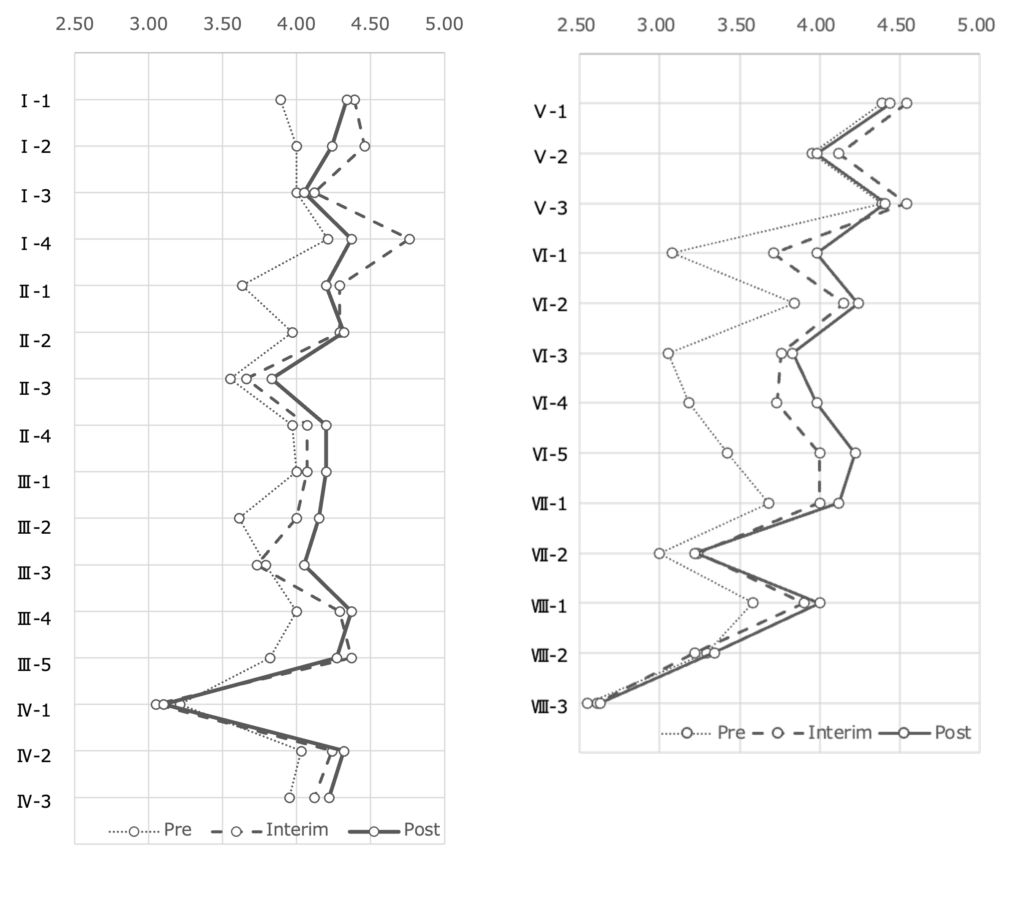Research Objectives and Overview
This study aims to develop a Global Technological Citizenship (GTC) education curriculum that fosters competencies to understand both the social benefits and harms of cutting-edge technology development and implementation. It also emphasizes the importance of individuals exercising their rights and responsibilities in technological development and institutionalization from a global perspective and ethical standpoint through dialectical risk communication.
To create a curriculum that can be implemented worldwide, a Japanese research team will collaborate with international partners and conduct field visits to universities in the United States, Japan, Indonesia, and Vietnam—regions with distinct infrastructures and social cultures. Using mixed research methods, the team will test and verify the effectiveness of the curriculum. Based on these findings, the team will refine and develop a global version of the GTC educational curriculum.
Project Members
|
Principal Investigator
|
Ayami Nakaya
|
Professor, Graduate School of Humanities and Social Sciences, Hiroshima University
|
|
Co- Investigator
|
Akimasa Fujiwara
|
Professor, The IDEC Institute, Hiroshima University
|
|
*****
|
****, Institute for Foreign Language Research and Education, Hiroshima University
|
|
|
Overseas Research Collaborators
|
Eisuke Saito
|
Senior Lecturer, Faculty of Education, Monash university, Australia
|
|
Suci Lestari Yuana
|
Lecturer, Department of International Relations, Gadjah Mada University, Indonesia
|
|
|
Maya Safira
|
Lecturer, School of Architecture, Planning, Policy Development, Institute of Technology, Bandung, Indonesia
|
|
|
David Eaton
|
Professor, LBJ School, University of Texas/Austin, USA
|
|
|
Seock-Jin Hong
|
Associate Professor, Aviation Logistics and Supply Chain Management, University of North Texas, USA
|
|
|
Le Anh Son
|
Professor, Vice Dean of R&D Center, Phenikaa University, Vietnam
|
|
|
Sang-Hwa Song
|
Professor, Graduate School of Logistics, Incheon National University, Korea
|
|
|
Varghese Varun
|
Assistant Professor, Department of Humanities and Social Sciences, IIT-Tirupati
|
Published Papers
Academic Papers (Peer-Reviewed and Non-Peer-Reviewed)
1.Influence of real and video-based experiences on stated acceptance of connected public transportation and autonomous vehicles in a transit mall: A hybrid choice modeling approach2023 (https://doi.org/10.1016/j.tra.2023.103695)
2.Does response lag affect travelers’ stated preference? Evidence from a real-time stated adaptation survey2023 (https://doi.org/10.1007/s11116-023-10435-8)
International Conference and Academic Presentation Materials
1.Human vs AI Robot in Mobility; Identity and Singularity2023
2.自動運転技術のシチズンシップ教育2023
3.Human vs AI Robot in Mobility; Shared Road Space2023
Working Paper
1.
2.
Data
Primary Analysis Results (No.17)
| Questions | Pre | Interim | Post |
| Ⅰ-1. 新たなモビリティ技術について関心がある | 3.89 | 4.39 | 4.34 |
| Ⅰ-2. 新たなモビリティ技術の開発を進めるべきだ | 4 | 4.46 | 4.24 |
| Ⅰ-3. 新たなモビリティ技術を利用すべきだ | 4 | 4.12 | 4.05 |
| Ⅰ-4. 新たなモビリティ技術に関する制度を整備すべきだ | 4.21 | 4.76 | 4.37 |
| Ⅱ-1. ロボット技術は色々な危険な場所で人間の助けとなる.しかし暴力にも利用されうる | 3.63 | 4.29 | 4.2 |
| Ⅱ-2. 新たなモビリティ技術でも交通事故を完全になくすことはできない | 3.97 | 4.29 | 4.32 |
| Ⅱ-3. 私が1日でも公共交通機関を使うとCO2排出削減につながる | 3.55 | 3.66 | 3.83 |
| Ⅱ-4. 公共交通機関を使う人が増えれば増えるほど,公共交通機関はより安く、便数が増える | 3.97 | 4.07 | 4.2 |
| Ⅲ-1. 新たなモビリティ技術で使われる人工知能が人間の知能を超える時が来る | 4 | 4.07 | 4.2 |
| Ⅲ-2. 新たなモビリティ技術は万能ではない | 3.61 | 4 | 4.15 |
| Ⅲ-3. 新たなモビリティ技術を適切に活用することで社会の課題は克服できる | 3.79 | 3.73 | 4.05 |
| Ⅲ-4. 新たなモビリティ技術は犯罪・軍事利用の可能性がある | 4 | 4.29 | 4.37 |
| Ⅲ-5. 新たなモビリティ技術はシステムの不具合で大事故を招く可能性がある | 3.82 | 4.37 | 4.27 |
| Ⅳ-1. 人間の運転能力を補う新たなモビリティ技術開発と利用は,人類の退化というリスクを生みだす | 3.21 | 3.05 | 3.1 |
| Ⅳ-2. 政府の新たなモビリティ技術に関する制度設計は,社会の持続可能な発展の成否に大きな影響を与える | 4.03 | 4.24 | 4.32 |
| Ⅳ-3. 私の新たなモビリティ技術の利用の仕方は,社会の持続可能な発展に影響する | 3.95 | 4.12 | 4.22 |
| Ⅴ-1. 技術者は持続可能な発展のために新たなモビリティ技術の開発に責任を持つ | 4.39 | 4.54 | 4.44 |
| Ⅴ-2. 市民は持続可能な発展のために新たなモビリティ技術の利用に責任を持つ | 3.95 | 4.12 | 3.98 |
| Ⅴ-3. 政府は持続可能な発展のために新たなモビリティ技術の制度設計に責任を持つ | 4.39 | 4.54 | 4.41 |
| Ⅵ-1. 私は他の人に新たなモビリティ技術に関するメリットやリスクや問題解決について自分の見解を説明できる | 3.08 | 3.71 | 3.98 |
| Ⅵ-2. 私は新たなモビリティ技術のメリットやリスクや問題解決について異なる意見を聞くことができる | 3.84 | 4.15 | 4.24 |
| Ⅵ-3. 私は新たなモビリティ技術のメリットやリスクや問題解決について異なる意見から新しいアイデアを生み出すことができる | 3.05 | 3.76 | 3.83 |
| Ⅵ-4. 私は,他の人に,モビリティ技術のメリットやリスクや問題解決についての自分の新しいアイデアを理解してもらうことができる | 3.18 | 3.73 | 3.98 |
| Ⅵ-5. 私は他の人たちと新たなモビリティ技術のリスクマネジメントについて合意形成することができる | 3.42 | 4 | 4.22 |
| Ⅶ-1. 私は自分のモビリティの問題の解決のために新たなモビリティ技術を使う | 3.68 | 4 | 4.12 |
| Ⅶ-2. 私は自分のモビリティ問題の解決に有効だとわかっていても、持続可能な発展にリスクがある新たなモビリティ技術は利用しない | 3 | 3.24 | 3.22 |
| Ⅷ-1. 私は新たなモビリティ技術についての情報を集める | 3.58 | 3.9 | 4 |
| Ⅷ-2. 私は新たなモビリティ技術についての勉強会や話し合いに参加する | 3.29 | 3.22 | 3.34 |
| Ⅷ-3. 私は新たなモビリティ技術について自らの意見をSNSで発信する | 2.55 | 2.61 | 2.63 |

Fund
|
Name
|
JSPS Scientific Research Grant, International Joint Research Acceleration Fund (International Joint Research Enhancement (B))
|
|
Period
|
FY 2022-2025
|
|
Research Plan
|
Aim of GTCE: GTC Competency
